第二章翻译的过程TheProcessofTranslation
英汉翻译 process of translation
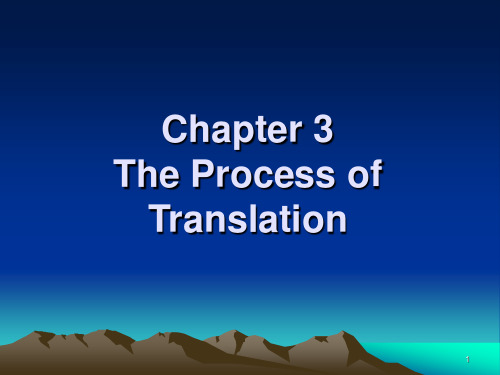
17
• 王小玉便启朱唇、发晧齿,唱了几句书 儿。 • 译文1:Now open her rosy lip and her ivory white teeth shine, her song begins! • 译文2:Little Jade Wang then opened her vermilion lips, displaying her sparking white teeth, and sang several phrases. • 译文3:Little Jade then parted her lips and sang a few lines.
8
译1: 一月三十一日,史迪威抵达德里。尽 管他对这个会议的态度十分消极,但最少 在二十九天来,他第一次有了个洗澡的机 会。
译2::一月三十一日,史迪威公开露面, 去德里参加会议。这次会议在他看看来不 管有多么消极,至少为他提供了一个二十 九天以来第一次洗澡的机会。
9
(3) Clare stood still, and inclined his face towards hers. “Oh, Tessy!” he exclaimed. The girl’s cheeks burned to the breeze, and she could not look into his eyes for the emotion. (Hardy: Tess ,Ch. 23)
accurate comprehension
smooth expression
Careful proof reading
the prerequisite of translation
a key factor
correcting & improving
2 翻译的过程
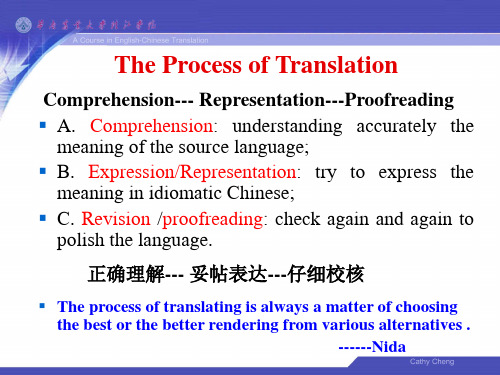
Representation(忘形,表达之母) 忘形,表达之母 忘形
1. 尽力表达出原文的信息并符合目的语的语言习惯。 尽力表达出原文的信息并符合目的语的语言习惯。 1)The old man lay all night on his sleepless bed. ) 老人躺在床上,彻底未眠。 老人躺在床上,彻底未眠。 2) In the doorway lay at least twelve umbrellas of all sizes ) and colors. A. 门口放着至少十二把各种颜色和尺寸的伞。 门口放着至少十二把各种颜色和尺寸的伞。 B. 门口放着至少十二把伞,五颜六色,大小不一。 门口放着至少十二把伞,五颜六色,大小不一。 3)The man was wearing a black suit, a pair of black shoes, a ) black beard, and a troubled look. 那人黑衣,黑鞋,黑络腮胡, 那人黑衣,黑鞋,黑络腮胡,黑着一张脸。
1. 正确理解词语意思 (Context) 1)The cows are dry. ) 这些母牛无奶。 这些母牛无奶。 2)He gave us a dry lecture yesterday. ) 昨天他给我们作了一场枯燥无味的讲座。 昨天他给我们作了一场枯燥无味的讲座。 3)No normal person could watch this film with dry ) eyes. 一般人看这部电影没有不掉眼泪的。 一般人看这部电影没有不掉眼泪的。
2. 表达出原文的感情色彩和风格。 表达出原文的感情色彩和风格。 1)He is nothing if not a cheat. ) 他不是个骗子才怪呢! 他不是个骗子才怪呢! 2)You should keep your nose out of here. ) 你少管闲事。 你少管闲事。 3)He is the last fit to do the job. ) 谁都能干这件事,就他不行。 谁都能干这件事,就他不行。
翻译的过程2
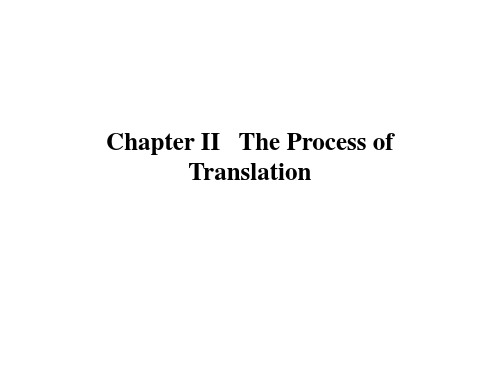
理解什么?
• 理解语言现象 译者必须上下有联系地理解原文的词汇含 义、句法结构和惯用法等。 Eg. 1. Suddenly the line went limp. “I’m going back,” said Kurth “We must have a break somewhere, wait for me. I’ll be back in five minutes.”
Which one is better?
• Translate literally, if possible, or appeal to free translation. • 能直译就尽量直译。直译能保存原作的某 种比喻手法或修辞手法,因而能达到与原 文近似的语言效果。 • 不能直译就采取意译。如果译文不能以与 原文相同的形式来再现原文的内容,只好 意译。
Literal translation
• 直译是指既忠实于原文内容又忠实于原文 形式的翻译方法(原文的比喻、形象和民 族或地域色彩)。 • 直译是把忠实于原文内容放在第一位,把 忠实于原文形式放在第二位,把通顺的译 文形式放在第三位的翻译方法。(许渊冲, 1978)
• We were moved to tears by his words. • 直译不是死译或硬译 • We saw an acrobat standing on his head.
Necessity of free translation
• 1. He had about as much chance of getting a job as of being chosen mayor of Chicago.
翻译的过程

翻译的过程The Process of Translation翻译的步骤Warming-up Exercises1. They gave the boy the lie.2. Fire goes wherever it can, but it prefers to follow a draught.3. The room was easily traced by the noise that was coming from it.4. I shall not expect you until I see you.参考译文1. 他们指责男孩说谎。
(他们指责男孩编造的这个谎言。
)2. 火是无孔不入的,可是它更爱窜入通风的地方。
3. 循声而去,便轻而易举地找到了那间屋子。
4. 你随便什么时候来吧。
翻译的过程通常包括理解、表达和校核三个阶段。
在翻译实践中,理解是表达的前提,但理解与表达通常是互相联系、相辅相成的统一过程,不能截然分开。
译者在理解原文的同时,也在选择表达方式;在表达的同时,又会进一步加深理解。
Three steps of translation翻译的三个步骤1.理解理解是翻译过程的第一阶段。
它既包括对语言现象、文化现象的理解,又包括逻辑关系的理解,对有可能发生歧义的语句要善于分析,进而做出正确判断。
例1:He allowed the father to be overruled by the judge, and declared his own son guilty. ( overrule: rule against)译文1:他允许法官驳倒父亲,宣布他自己的儿子有罪。
译文2:法官的责任感战胜了父子私情,他还是宣判(自己的)儿子有罪。
例2:If we try to implement these harebrained ideas (that English should be replaced by Hindi and the 15 recognized state languages), India will become a Tower of Babel. (harebrained: very foolish)译文1:如果我们试图实施这些轻率而愚蠢的主张,以印度语和其他15种官方承认的各邦语言取代英语的话,印度就会成为一座通天巴别塔。
第二章-翻译的过程PPT课件
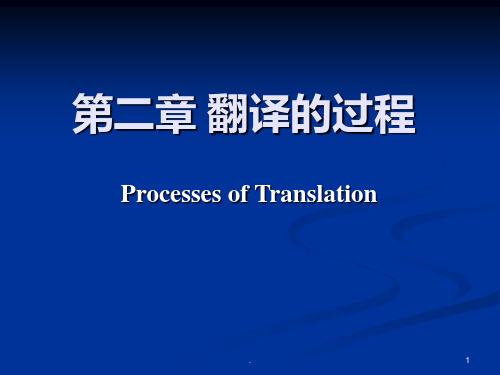
.
8
tediousness
Minority ethnic group
.
9
2.2 流畅表达(Fluency in ExpressiБайду номын сангаасg)
表达是理解后能否保证成功的又一重要关 键步骤,是理解的深化和表达,译者要恰 当好处的再现原文的内容。能直译时就直 译,不能直译在考虑意译。
例1: Medicinal Herbs help cough.
2) Do you have anything to declare? (in Customs)
3) They declared themselves against the plan.
.
4
2.1.1 正确理解句子
例1:The woman who said she saw the murderer wears glasses.
科学家证实了青鱼生存所需温度。
.
13
2.2.3 句子的表达
例3. Gauss published some 155 titles during his lifetimes, and he left behind a large quantity of unpublished work.
高斯一生发表过约155篇论文,而且还留下 了大量未发表过的作品。
当您意识到您的杰出事业是如此广泛的受 到尊敬与欣赏,您就会为自己增添力量。
.
7
2.1.2 正确理解段落与篇章
例1:
It is hardly possible here to summarize his ideas. Suffice it to point out /say that they constitute a dependable response to the demands of a crisis which steadily increases the feelings of helplessness and hopelessness of the individual by asserting his primacy and supremacy and open up a perspective of restoring sanity and decency in public life.
翻译的过程,2010. 11. Chapter 2 Process of Translation (1)-文档资料
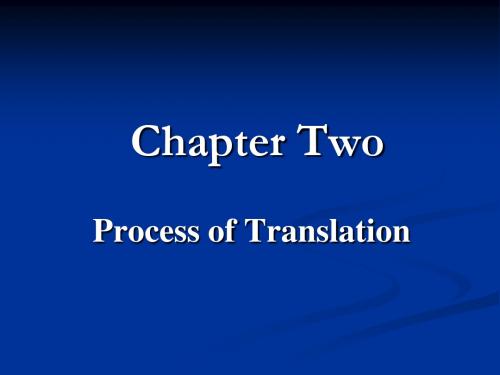
Restructuring 指重组目标语言。也就是打破 源语言的语言结构框架,重新组织目标语 言,合理并句、断句、拆句、选词造句或 选定句型调整顺序,把源语言中的重要信 息按目标语的语言习惯进行恰如其分的表 达,最后呈现给读者。例如:
例1:Some had beautiful eyes, others a beautiful nose, others a beautiful mouth and figure: few, if any, had all. (Thomas Hardy: Tess of the d’Urbervilles)
Analysis 指分析待译的语言材料。也就 是分析原文各层次的语义,包括词、 短语、句子的基本意义、字面意义、 内涵意义、关联意义、引申意义、抽 象意义或具体意义、文化意义或社会 意义等,分析结构关系、上下关系、 逻辑关系等,对原文有一个比较全面 的了解,有一个总体的印象。
Transfer 指把源语言材料转换成目标语 言。也就是在分析原文的基础上,把所 分析好的语言材料,运用不同的语码, 把原文所表达的思想内容准确地转入到 译文中来,在目标语中再现原文的风貌。 转换的好坏取决于对源语言的掌握程度 以及对源语言分析理解的深度。
(4) 好几个人摸摸头,摸摸脖子,说下得好没意思, 不知谁是赢家,就有几个人离开走出去,把油灯 带得一明一暗。(《棋王》)
原译:Quite a few of the spectators started scratching their heads and their necks and saying that this was atell who was winning. Some of them left, taking some of the oil lamps with them and leaving the room half in darkness.
第二章 翻译的过程
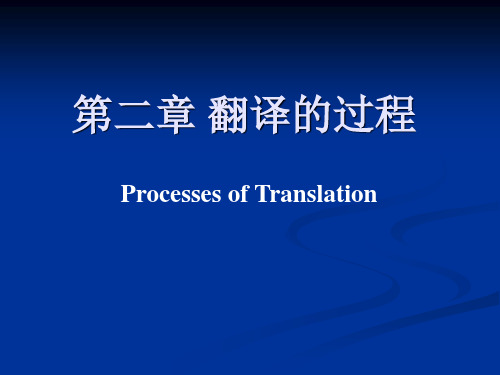
2.2.4 整体篇章表达
例2. A few days later, with appeals to the Supreme Court and Governor Arnold Schwarzenegger both rejected, Clarence Ray Allen, a blind, diabetic 76-year-old convicted of have three people killed, including his son’s girlfriend, was helped from his wheelchair and put to death by lethal injection in California.
2.2.4 整体篇章表达
例1:it was the best of times, it was the worst of times; it was the age of wisdom, it was the age of foolishness; it was the epoch of belief, it was the epoch of incredulity; it was the season of the Light, it was the season of the Darkness; it was the spring of Hope, it was the winter of Despair; we had everything before us, we had nothing before us; we were all going to Heaven, we were all going direct the other way.
The Process of Translation
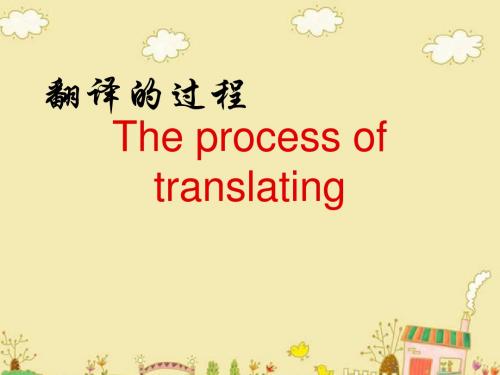
所指层次(The referential level)
Whether a text is technical or literary or institutional, you have to make up your mind. summarily and continuously, what it is about, what it is in aid of. what the writer's peculiar slant on it is.
例
i.e. 唐长安城包括今西安城和近郊区,面积相当于现在西安城的七倍 半,城周有三十六点七公里,城内居住着约一百万人口。
译: The Chang’an City in the Tang Dynasty included today’s Xi’an city
proper and its suburbs. Its area was seven and a half times as large as Xi’an city. Its circumference was 36.7 kilometers. There lived about one million people in the city.
appreciate and evaluate awesome and amazing tidy and ordered
自然层次(Naturalness)
the translation makes sense; it reads naturally, that it is written in ordinary language, the common grammar, idioms and words that meet that kind of situation.
英语翻译的过程
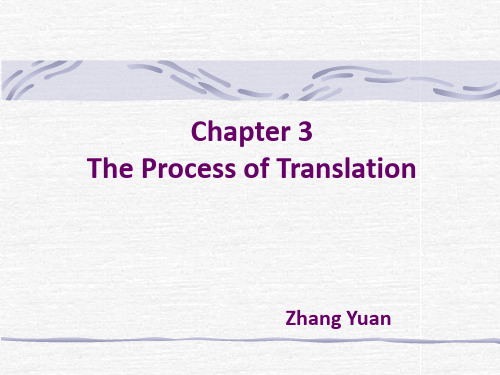
确切理解单词意义的方法
翻译过程的理解同一般的阅读理解有区别: 英译汉过程中的理解,指解读原文以最大 程度地获取原文所蕴含的信息量。 方法: • 有效地扩大词汇量,减少理解中的“拦路虎”。 • 根据上下文语境和词语搭配进行判断 • 重视熟悉单词的一词多义现象。
课堂互动:判断哪个译文正确?
1. I was so angry that I couldn’t find my tongue.
Texts
理解是英汉翻译过程中的第一步,也是整个过程中 最关键的一步。译者能否准确地表达原文的思想内 容,关键在于是否准确理解了原文。因此,理解是 表达的基础,是表达的先决条件。没有正确的理解 就不可能有忠实的译文,当然也谈不上通畅、自然 的表达。
Question:How to accurately comprehend the original text? 例1:If it worked once, it can work twice.
I. Lead-in
Warming-up question:
Please tell us what is your own process of translation?
II. Explanations on the process of translation
The four basic processes in translating consist of (1) analysis of the source text, (2) transfer from source to target language, (3) restructuring in the target language, (4) testing of the translated text with persons who represent the intended audience.
英语翻译的步骤The Procedures for Translation
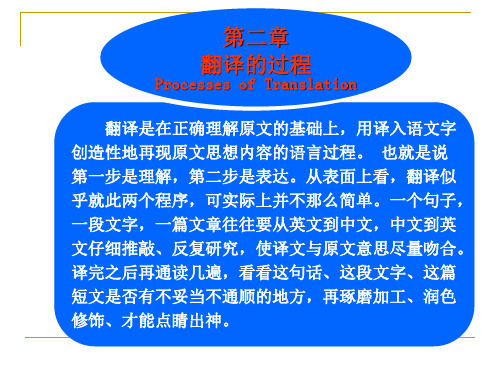
4. Her bright red hat killed the quiet colour of her dress. 5.That killed him around here. 6. He is killing me. 7. The troops of the two countries are kept at arm‟s length. 8.If I want you I‟ll ask for you.
理解之后--表达
How to give an exact representation after you have acquired accurate comprehension: 表达是理解的继续和升华,表达的好坏与理解 的深度,译文语言的熟练程度,翻译技巧的掌 握程度有关.
2. 2. 1 关键词的表达
The question before the house is one of awful moments to our country. 摆在全体代表面前的是关系到我国危急存亡的 重大问题。 The boys have their respective future dreams. 那几个少年对未来各有梦想。 The nursing of the sick ,said Nightingale, is a vocation as well as a profession. 南丁格尔说:看护患者不仅是一种职业,更是 天职。
准确理解是确切表达的前提,理解的诸多 方面如图所示。词义的选择
固定搭配、成语、短语、惯用词组 理解 歧义 矛盾修辞 逻辑关系 夸张 重复 平行结构 正确理解语言现象, 不仅要了解句子的字面意义,还要 了解句子的内涵意义。必须上下有联系地、全面地理解原 文的词汇含义、语法关系和逻辑修辞。不能孤立地看待一 句一词,因为同一个词或一个词组,在不同的上下文和不 同的语法结构中,往往有不同的含义。有时不同词义的词 却被认为是同义词,而同一词在不同的上下文中又产生了 不同的含义。 篇章 段落 词句
第二次课--翻译的过程及策略选择
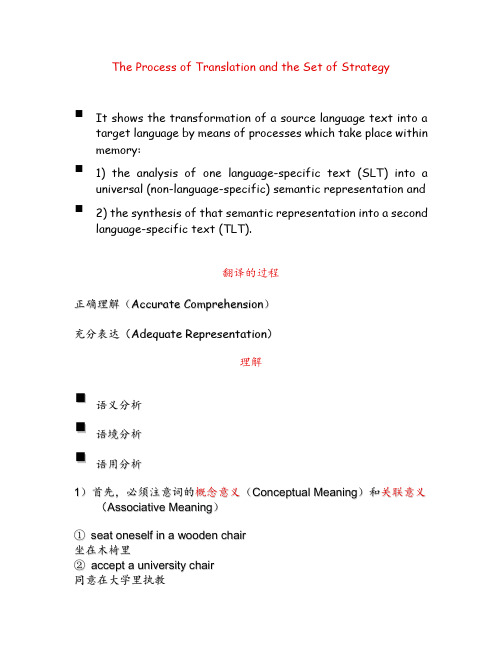
▪ “摇旗呐喊,擂鼓鸣锣,大刀阔斧,杀奔祝家庄来。”
▪ Pearl S. Buck的译文: ▪ “Then waving their flags and shouting their war cries, beating
their drums and gongs with their great knives and their broadaxes, they went charging toward the village, killing as they went until they might reach the Ridge of the Lonely Dragon.”
① seat oneself in a wooden chair 坐在木椅里 ② accept a university chair 同意在大学里执教
③ chair the board meeting 主持董事会 ④ condemned to the chair 被处电刑
2)把握意义关系(Sense Relations),特别注意同义与反义、褒义与 贬义、多义与歧义等关系。
▪ 上海警方昨日在火车站抓住了一伙贩卖火车票的黄牛。
▪ 译文:Yesterday, the police caught a gang of scalpers at
Shanghai Train Station.
▪ 在第十七回“大观园试才题对额”里,贾政带领众人来到一石碣处,
命众人题字,众人建议直书“杏花村”。贾政听了,笑向贾珍道:“正
name: ‘Apricot Village’.”
▪ Jia Zheng knew that he was referring to the words of the
翻译的过程TheProcessofTranslation
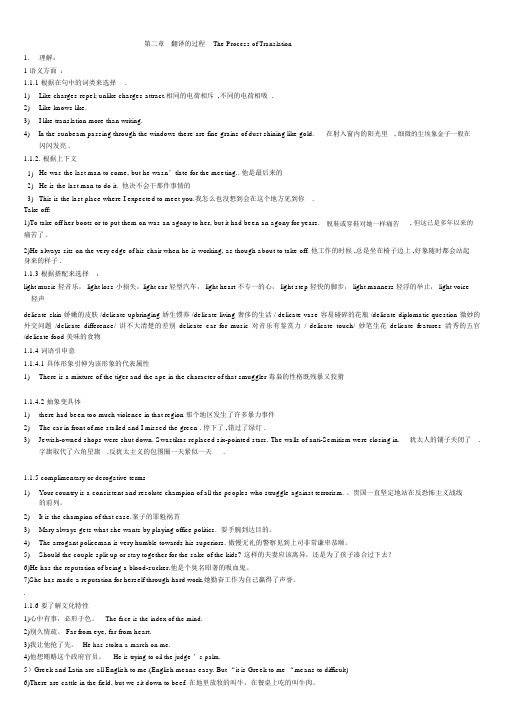
第二章翻译的过程The Process of Translation1.理解:1 语义方面:1.1.1 根据在句中的词类来选择.1)Like charges repel; unlike charges attract.相同的电荷相斥 ,不同的电荷相吸 .2)Like knows like.3)I like translation more than writing.4) In the sunbeam passing through the windows there are fine grains of dust shining like gold.在射入窗内的阳光里, 细微的尘埃象金子一般在闪闪发亮 .1.1.2. 根据上下文1) He was the last man to come, but he wasn’tlate for the meeting.. 他是最后来的2) He is the last man to do it. 他决不会干那件事情的3) This is the last place where I expected to meet you.我怎么也没想到会在这个地方见到你 .Take off:1)To take off her boots or to put them on was an agony to her, but it had been an agony for years.脱鞋或穿鞋对她一样痛苦, 但这已是多年以来的痛苦了 .2)He always sits on the very edge of his chair when he is working, as though about to take off. 他工作的时候 ,总是坐在椅子边上 ,好象随时都会站起身来的样子 .1.1.3 根据搭配来选择:light music 轻音乐, light loss 小损失,light car 轻型汽车, light heart 不专一的心, light step 轻快的脚步, light manners 轻浮的举止, light voice 轻声delicate skin 娇嫩的皮肤 /delicate upbringing 娇生惯养 /delicate living 奢侈的生活 / delicate vase 容易碰碎的花瓶 /delicate diplomatic question 微妙的外交问题/delicate difference/ 讲不大清楚的差别delicate ear for music 对音乐有鉴赏力/ delicate touch/ 妙笔生花delicate features 清秀的五官/delicate food 美味的食物1.1.4 词语引申意1.1.4.1 具体形象引伸为该形象的代表属性1)There is a mixture of the tiger and the ape in the character of that smuggler 毒枭的性格既残暴又狡猾1.1.4.2 抽象变具体1)there had been too much violence in that region 那个地区发生了许多暴力事件2)The car in front of me stalled and I missed the green . 停下了 ,错过了绿灯 .3) Jewish-owned shops were shut down. Swastikas replaced six-pointed stars. The walls of anti-Semitism were closing in.犹太人的铺子关闭了.字旗取代了六角星旗.反犹太主义的包围圈一天紧似一天.1.1.5 complimentary or derogative terms1)Your country is a consistent and resolute champion of all the peoples who struggle against terrorism. 。
2.翻译过程解析

我们上车时,我看见司机和卖票员正冲车站酒 吧里出来。 改译:我们上车时,我看见司机兼列车长正冲车 站酒吧里出来。
1) 句子的理解
句子是表达一个完整思想的、具有一定语法特征 的最基本的语言单位。翻译是不能只看半句话或开头 几个词就动笔去译,要读完整个一句话,搞清句子结 构,分析句子成分,句子传达的是什么意思,肯定什 么,否定什么,提出什么问题,表达什么愿望或情感, 是否隐含什么,是否话中有话;还要看语言环境,根
注: George Steiner (乔治· 斯坦纳) , 英国剑桥大学教授, 英国翻译理论家,语言学家 。 代表作:《通天塔之后:语言与翻译面面观》 (After Babel: Aspects of Language And Translation)
3. 中国传统方法:理解、表达、审校
Comprehension, Expression & Check(revision)
今年10月19日,正好也是星期五。那是个秋日的下 午,日色朦胧,埃德加• 斯诺骨灰的一部分运回到了 北京大学校园并永远地安放在这里;他年轻时曾在这 里的新闻系任教,当时叫“燕京大学”。
II、表达(Expression)/Restructuring
所谓表达则是把自己所理解的内容,忠实而通顺地传达给
据一定的背景知识等。
对词语意义、语法结构、逻辑关系、上下文关系、 文化背景和专业知识等方面的理解。
(1)词语意义
词语意义应根据原句的主题内容、词汇的词性、搭配 关系以及词义的引申或褒贬等来确定。
Having discovered an unknown island, they wintered upon it. 他们发现了一个无名小岛后,便住了下来,在那里过冬。 Every life has its roses and thorns. 每个人的生活都有甜有苦。
文学翻译十讲-第二章详解-刘重德

1.
2.
The question of making supplementary remarks
• So far as true translation is concerned, ―the translator’s note‖ should not be adopted. ― What should translator do ? • Have a though comprehension of the sense and spirit of the whole text and then translate as it is • Pay enough attention to the coherence of the text • Add footnotes to have difficult words or expressions further illustrated
Gone are the days when they ran wild in our country and lorded it over the people. • 他们在我国胡作非为、对人民称王称霸的 日子已经一去不复返了。
Chinese ---English
• You will have to take into consideration the feature of well-knitness of English sentences and ― well change some commas, semicolons and may colons into full stops where necessary. • Judging from the feature of the structure of the English syntax, it is all right for the English version to divide the original one sentence into two. 我们的民族将再也不是一个被人侮辱的民族了,我 们已经站起来了。 Ours will no longer be a nation subject to insult and humiliation. We have stood up.
教案5:翻译的过程

The Process of Translation翻译的过程1. Hatim &Mason's View:Hatim &Mason states in their book “Discourse and The Translator”:“Aids to translators are improving all the time, but the basic problems faced by translators in their work remain the same. In broad and general terms, these can be listed as follows:(1) Comprehension of source text:(a) parsing of text (grammar and lexis)(b) access to specialised knowledge(c) access to intended meaning(2) Transfer of meaning(a) relaying lexical meaning(b) relaying grammatical meaning(c) relaying rhetorical meaning, including implied or inferrable meaning, for potential readers.(3) Assessment of target text:(a) readability(b) conforming to generic and discoursal conventions(c) judging adequacy of translation for specified purpose.” (2001: 21)2. Peter Newmark's View:the SL text levelthe process the referential levelthe cohesive levelthe level of naturalness1.文本层次(the SL text level)----指原文的字面意思。
新英汉翻译教程 第一二章翻译的过程答案
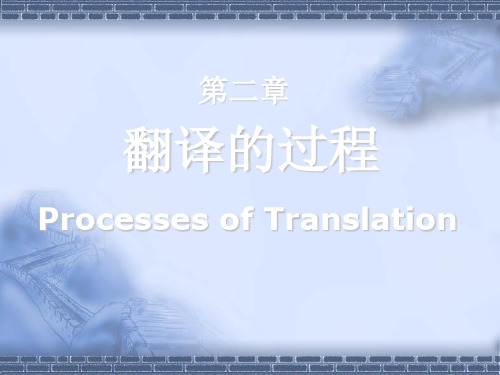
20 返回章重点 退出
【译文】让我们回到密西西比去,回到亚拉巴 马去,回到南卡罗来纳去,回到佐治亚去,回到 路易斯安娜去,回到我们北方城市中的贫民区和 少数民族居住区去。要牢记,这种状况是能够, 也必将改变的。我们不要陷入绝望而不可自拔。 朋友们,今天我对你们说,在此时此刻,我 们虽然遭受种种困难和挫折,我仍然有一个梦想。 这个梦想是深深扎根于美国的梦想中的。 我梦想有一天,这个国家会站起来,真正实 现其信条的真谛:“我们认为这些真理是不言而 喻的:人人生而平等。”
【译文】话说,人生幸福只需三条: 有所爱,有所为,有所盼。
15 返回章重点 退出
课堂互动1 :翻译句子(参考译文)
4.He smiled at that, with a rueful curve of his lips, but his eyes were alight with an emotion she was afraid to identify.
步是表达。
3 返回章重点 退出
优美的译文必须经过下列翻译过程 :
翻译的过程
理解 分析 总体了解 表达 转换 重现原文 审校 润色 点睛出神 小点结束
4 返回章重点 退出
2. 1 正确理解
(Comprehension Reading)
5 返回章重点 退出
理解的诸多方面如图所示 :
篇章 段落 词句 词义的选择 固定搭配、成语、短语、惯用词组 歧义 矛盾修辞 逻辑关系 夸张 重复 平行结构 ……
理解
6 返回章重点 退出
2. 1. 1 正确理解句子
句子是表达一个完整思想的、具有一定语 法特征的最基本的语言单位。翻译是不能只看 半句话或开头几个词就动笔去译,要读完整个 一句话,搞清句子结构,分析句子成分,句子 传达的是什么意思,肯定什么,否定什么,提 出什么问题,表达什么愿望或情感,是否隐含 什么,是否话中有话;还要看语言环境,根据 一定的背景知识等。
- 1、下载文档前请自行甄别文档内容的完整性,平台不提供额外的编辑、内容补充、找答案等附加服务。
- 2、"仅部分预览"的文档,不可在线预览部分如存在完整性等问题,可反馈申请退款(可完整预览的文档不适用该条件!)。
- 3、如文档侵犯您的权益,请联系客服反馈,我们会尽快为您处理(人工客服工作时间:9:00-18:30)。
第二章翻译的过程The Process of Translation1.理解:1语义方面:1.1.1根据在句中的词类来选择.1)Like charges repel; unlike charges attract.相同的电荷相斥,不同的电荷相吸.2)Like knows like.3)I like translation more than writing.4)In the sunbeam passing through the windows there are fine grains of dust shining like gold. 在射入窗内的阳光里,细微的尘埃象金子一般在闪闪发亮.1.1.2. 根据上下文1)He was the last man to come, but he wasn’t late for the meeting..他是最后来的2)He is the last man to do it. 他决不会干那件事情的3)This is the last place where I expected to meet you.我怎么也没想到会在这个地方见到你.Take off:1)To take off her boots or to put them on was an agony to her, but it had been an agony for years.脱鞋或穿鞋对她一样痛苦,但这已是多年以来的痛苦了.2)He always sits on the very edge of his chair when he is working, as though about to take off.他工作的时候,总是坐在椅子边上,好象随时都会站起身来的样子.1.1.3 根据搭配来选择:light music轻音乐,light loss小损失,light car轻型汽车,light heart不专一的心,light step轻快的脚步,light manners轻浮的举止,light voice 轻声delicate skin娇嫩的皮肤/delicate upbringing娇生惯养/delicate living奢侈的生活/ delicate vase容易碰碎的花瓶/delicate diplomatic question微妙的外交问题/delicate difference/讲不大清楚的差别delicate ear for music对音乐有鉴赏力/ delicate touch/妙笔生花delicate features清秀的五官/delicate food美味的食物1.1.4 词语引申意1.1.4.1 具体形象引伸为该形象的代表属性1)There is a mixture of the tiger and the ape in the character of that smuggler毒枭的性格既残暴又狡猾1.1.4.2 抽象变具体1)there had been too much violence in that region那个地区发生了许多暴力事件2)The car in front of me stalled and I missed the green .停下了,错过了绿灯.3)Jewish-owned shops were shut down. Swastikas replaced six-pointed stars. The walls of anti-Semitism were closing in.犹太人的铺子关闭了.字旗取代了六角星旗.反犹太主义的包围圈一天紧似一天.1.1.5 complimentary or derogative terms1)Your country is a consistent and resolute champion of all the peoples who struggle against terrorism.。
贵国一直坚定地站在反恐怖主义战线的前列。
2)It is the champion of that case.案子的罪魁祸首3)Mary always gets what she wants by playing office politics.耍手腕到达目的。
4)The arrogant policeman is very humble towards his superiors.傲慢无礼的警察见到上司非常谦卑恭顺。
5)Should the couple split up or stay together for the sake of the kids?这样的夫妻应该离异,还是为了孩子凑合过下去?6)He has the reputation of being a blood-sucker.他是个臭名昭著的吸血鬼。
7)She has made a reputation for herself through hard work.她勤奋工作为自己赢得了声誉。
.1.1.6要了解文化特性1)心中有事,必形于色。
The face is the index of the mind.2)别久情疏。
Far from eye, far from heart.3)我让他抢了先。
He has stolen a march on me.4)他想贿赂这个政府官员。
He is trying to oil the judge’s palm.5)Greek and Latin are all English to me.(English means easy. But “it is Greek to me “means to difficult)6)There are cattle in the field, but we sit down to beef.在地里放牧的叫牛,在餐桌上吃的叫牛肉。
7) It is a black lie.恶意的谎言。
8).From time to time, we have to do rather tricky job and feel that one of our fingers is getting in the way. We say that we are all thumbs. 我们有时要干些精细的活,但感到手指不听使唤,我们说自己苯手苯脚的。
9)请你耐心一点。
To hold your potato10)The couple lead a cat and dog life. 这对夫妻老吵架。
11).John can be relied on, he eats no fish and plays the game约翰为人可靠,他既诚实又正直。
1.2语境分析:分析词与周边逻辑关系。
1)We must insert a new fuse every time fuse has functioned.每当保险丝烧断后,我们就换上新的。
2)-------“Well, old boy, ”said the visitor, “it’s nice to see you up and about”-----“Up , yes, ”the patient said, “but about , no —at least not much,”-------“喂,老兄,”探视者说,“见到你起来走动走动,真高兴。
”------“是能下床了,”病人答到。
“若说走动还步行—至少还不太行。
”3)-----Clare stood still, and inclined his face towards hers.-------“ Oh, Tessy!” he exclaimed.-----The girl’s cheeks burned to the breeze, and she could not look into his eyes for the emotion.( T. Hardy: Tess of the d’Urbervilles, Ch. 23)克来站住了脚,把脸贴/俯向来丝的脸。
“哦,台丝?”他动情的叫到。
苔丝感到了他的呼吸,脸上给烧得火辣辣的,她心摇神荡,不敢再盯着克来的眼睛。
1.3语用分析对语言的交际意义进行分析。
1.3.1了解说话人的感情,态度,情绪和意念等1)Say that again and I’ll part with you once an d for all.(警告)你再这样说,我就不再理睬你了。
2)You are stubborn. He is pig-headed. I am strong-willed.(褒、贬有别)你太固执,他是头倔驴,而我却意志坚强。
3)He is a post-graduated, but speaks no English.(表惊讶)他是个研究生,奇怪的是连一句英语都不会说。
4)A down-to-earth man would have succeeded.(含假设)如果脚踏实地,就不会失败了。
1.3.2选词对风格的影响:用词不同,句法结构不同, 表现手法不同,从而导致了风格的不同.1)Beside the flashing light, Miller had frequent but not severe headache , which he attributed to business tension, lack of exercise and too manycigarettes. At 42, he had realized the ambition of many bright young engineers: to own a manufacturing business.2)I joined the Marine Corps at seventeen. I was very mixed up. I wanted to become a first-class citizen. I wanted to be accepted and I was veryproud of my uniform. My mom didn’t want to sigh the papers, but she knew I had to better myself and maybe I’d get an education in the services.1.3.3风格对意义的影响:原文的意图不同,表达方式不同. 形式对意义的影响.1)40-Lovemiddle agedcouple playingten- niswhen thegame endsand theygo homethe netwill stillbe be-tween them2.表达阶段2.1直译与意译之争2.1.1直译:强调“形似”1)John is a clean-cut , great-looking guy. 是一个干净利落,相貌伟大\岸的人.2)Endless African plain. The sun is bright, the trees are green and the animals live happily.一望无际的非洲平原,阳关道明媚,树木葱绿,动物们幸福地生活着.3)You toil and work and earn bread, and I’ll eat it.你们流汗劳动换来的面包,我坐享其成。
